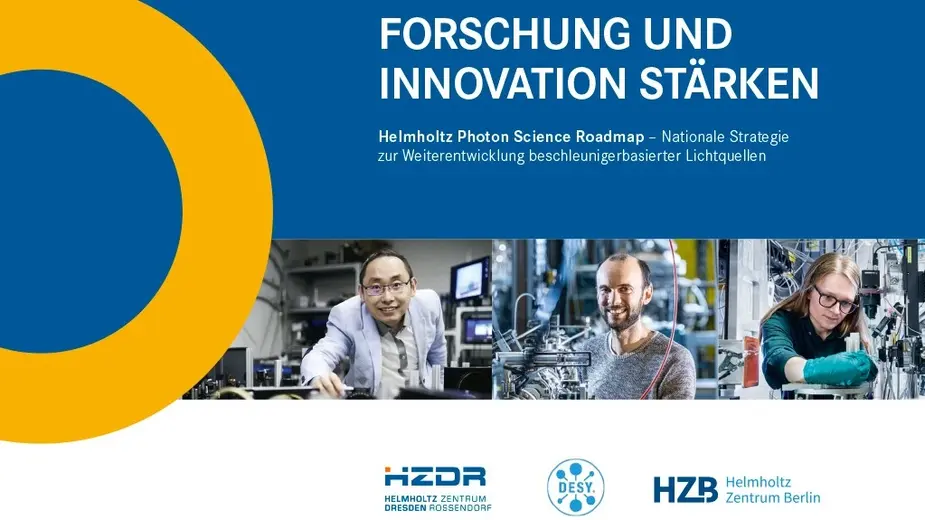Tailwind for top research in Germany
Research centers of the Helmholtz Association present upgrade strategy for accelerator-based facilities
Three research centres in the Helmholtz Association have developed a joint future plan for the research conducted at the scientific light sources they operate in Hamburg, Berlin and Dresden. The upgrades proposed in the strategy for their world-class accelerator-based facilities will strengthen Germany as a research location and promote innovations in many different fields. The strategy paper was presented on 28 June at the Helmholtz Symposium “Research Infrastructures of the Future” as a component of the Helmholtz Roadmap.
The light sources of the Helmholtz Association complement each other and are true multitalents: they are teaching us about the coronavirus and tracking down candidates for new drugs. They are analysing catalysts that produce hydrogen from sunlight and could therefore pave the way towards a climate-neutral economy. They are delivering insights into novel materials as part of our advancing digitalisation. And, together, these light sources are securing Germany’s innovative advantage in many more areas.
Professor Helmut Dosch, coordinator of the Helmholtz research field Matter and chair of the DESY Directorate, explains: “Large-scale accelerator-based facilities are indispensable for research projects in all scientific disciplines. With our light sources in Hamburg, Berlin and Dresden, we therefore fulfil an essential social mandate in securing Germany’s international leadership in this dynamic field of the future.”
To ensure this remains so in the future, the facilities of tomorrow must be planned today. The three Helmholtz Centres in Hamburg (DESY), Berlin (HZB) and Dresden (HZDR) have therefore jointly developed a national strategy for upgrading their accelerator-based light sources. One thing the research centres have in common is that their large-scale research facilities are highly successful in the international cooperation.
Professor Sebastian M. Schmidt, Scientific Director at HZDR, adds: “That is exactly what sets the Helmholtz Association apart: we have the future’s questions in our sights now. Only this way do we manage, time and again, to identify tomorrow’s research topics with foresight and to plan the necessary infrastructures for developing groundbreaking solutions. To continue this, we are now appealing for broad support for our strategy.”
The planned modernisations will give research a push in the right direction for the future: the improved light sources will present unique research opportunities in Germany for areas such as high-tech materials, environmental issues, energy sources, information technology, medicine and cultural heritage.
Professor Jan Lüning, Scientific Director at HZB, emphasises: “Our facilities complement each other perfectly. Between them, they comprehensively cover the experimental methods needed in science. The facilities thus guarantee that we will be ready to tackle even the future challenges in science and industry, and thus hold a lead position internationally.”
A brief outline of the planned updates:
At DESY in Hamburg, the existing light source PETRA III will be upgraded to PETRA IV. The X-ray light it provides can be used to watch atomic structures of materials under live process conditions. More powerful batteries, new medical drugs against common diseases, or tailored materials for quantum electronics: the deep insights it will give us into the nanocosmos will let us make great scientific strides forward. Once complete, DESY’s 3D X-ray microscope will be unique in the world.
BESSY III will become the new discovery machine for energy and materials research. Its soft X-rays will reveal spatially resolved information about electronic properties. So-called operando methods will allow real-time research that delivers new insights into the functionality of materials. This will help quantum computers and high-tech materials for producing green hydrogen through artificial photosynthesis to become a reality.
In Dresden, a new research facility is being created with two superconducting electron accelerators: DALI. This will deliver terahertz and vacuum ultraviolet radiation. Its light will be used to decipher the nature of materials used in ultrafast data processing technologies, for example successors to the 5G mobile network standard. Biophysics will be another field to benefit from the new facility, which will allow not only the observation but even the targeted control of metabolic processes at the cellular level.
Yet another measure will be the continued modernisation of the free-electron laser FLASH2020+ at DESY. Once the conversion phase is finished, the FLASH facility will hold a world leading position among free-electron lasers for soft X-rays and terahertz light.
The overall strategy of the Helmholtz Photon Science Roadmap also includes ongoing involvement in the internationally operated X-ray laser European XFEL.
Three centres, one strategy
A summary of the national strategy for the upgrading of accelerator-based light sources is given in the brochure “Forschung und Innovation stärken” (Strengthening Research and Innovation) (in German, tablet-optimised PDF with 16 pages -in download on the right column)
Please find here the long version: https://www.helmholtz.de/en/research/matter/
What is an accelerator-based light source (photon source)?
- Accelerated electrons produce high intensity light pulses with wavelengths in the spectral region from infrared to beyond X-rays. This light can be used to study materials and samples of nearly any kind.
- Two kinds of photon sources are storage rings and free-electron lasers (FEL). These are different in design and purpose: storage rings are fully circular and generate short pulses of light at overall high intensity; FELs are linear and generate ultrashort laser pulses of extreme brilliance.
- Some of these important research infrastructures are kilometres long.
Contact :
HZDR: Simon Schmitt
Tel.: +49 351 260 3400 | Mobil: +49 175 874 2865 | E-Mail: s.schmitt(at)hzdr.de
HZB: Dr. Ina Helms
Tel.: +49 30 8062 - 42034 I E-Mail: ina.helms(at)helmholtz-berlin.de
DESY: Dr. Thomas Zoufal I Pressesprecher
Tel.: +49 40 8998 1666 I E-Mail: thomas.zoufal(at)desy.de
Joint Press Release, Berlin, Dresden, Hamburg, June, 28th 2021
